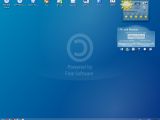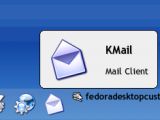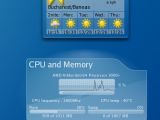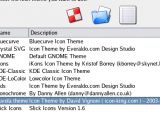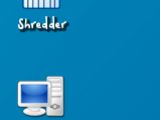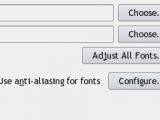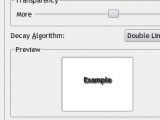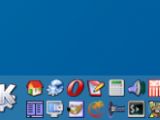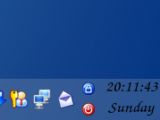As I've promised in my previous guide, "Fedora Core 5 Installation Guide", I will show you some tricks on desktop customization. In other words, how to get from:
First of all, I've used KDE for this guide, so if you usually use GNOME, then this guide is not for you. Second, the desktop resolution used in this is 1280x1024. Good, now let's get to work and bring the desktop to life.Step 1 - Transparency, Themes and Eye Candy Effects
We need to get a nicer theme for the system, because "Bluecurve" looks ugly and old, and the point of this guide is to show the world that Linux is anything but old, representing, in fact, the future.
The Theme
Right, now go to Control Center -> Appearance & Themes -> Theme Manager and click on "Plastik" theme, and then hit the Apply button. Wait a few seconds for the theme to be applied and you'll see the buttons and the windows changing into a nice looking theme.
The Transparency and some eye candy effects
We need to make the kicker transparent, so we have to go to Control Center -> Desktop -> Panels and in the first tab, "Arrangement", we select the 'Position' to Bottom Center and the Size to Normal. Then hit Apply. Next, we go to "Appearance" tab and check the 'Enable icon mouseover effects' option and at 'Panel Background' section, select 'Enable transparency' option, then hit the Advanced Options button and, in the window that appears, check the 'Hide' option on the 'Applet Handles' section and move the slider of the 'Tint amount' from the 'Transparency' section a little more to Min. Also, check the 'Also apply to panel with menu bar' option. Hit OK and then again Apply.
The Desktop Widgets
Every modern desktop has now widgets on desktop, so we have to add some eye candy widgets on our desktop too. Go to the KDE Menu -> Utilities -> Desktop and click on SuperKaramba. A window will appear, click on "New Stuff..." button and choose from the list of widgets that appears the ones you like most and install them. I have installed the Aero AIO widget and the very popular Liquid Weather.
You can get the latest version of Liquid Weather from Softpedia.
Step 2 - Fonts, icons and a nice wallpaper.
We need to get some TTF fonts, a nice icon theme and a good looking wallpaper.
The Icons
I've chosen the Nuvola icon theme: it's a cartoonish-like theme, but very "warm" to the eye. You can get it from here.
Go to Control Center -> Appearance & Themes -> Icons and install the Nuvola theme that you've just downloaded. After it's installed, you will see it on the list of icon themes; click on it and push the Apply button. You will notice that most of the visible icons are changed.
Optional, we can get bigger icons on the desktop if we go to Control Center -> Appearance & Themes -> Icons and click on the Advanced tab, select "Desktop/File Manager" icons and choose in the right, Size 48. Hit Apply and you'll see bigger and nicer looking icons on the desktop.
The Fonts
Let's get some nice fonts for the desktop icons and for the whole system! I chose to install the msttcorefonts, which you can download from here. After you've finished downloading, open up a console and type the following command:
rpm -ivh msttcorefonts-2.0-1.noarch.rpm
and then type this command to restart the font server
/etc/init.d/xfs restart
NOTE: In most cases, you need to log out and then log back in so the fonts can be activated.
Go to Control Center -> Appearance & Themes -> Fonts and click on the Adjust All Fonts button.
I've selected from the list Trebuchet MS font, Regular and Size 10. Hit the Apply button and you'll notice that the fonts are changed now.
Now, for the desktop icons font, I have found a very nice font called Space Cowboy, which you can get from here. After download, unzip the file and copy the "cowboy.ttf" file to the "/usr/share/fonts/msttcorefonts" folder. Go again to Control Center -> Appearance & Themes -> Fonts and choose from the end of the list the "space cowboy" font at Size 12. Click OK and then Apply and the desktop icons will have a new cool font.
NOTE: You need to log out then log back in for the font to appear in the list of fonts.
The Shadow of the fonts:
There is no font shadow implemented in Fedora for the desktop icons, so we need to get and install a package called "TextShadowEdit", which you can download from here. After you have installed the "TextShadowEdit" package, you can find it in Control Center -> Appearance & Themes -> Desktop Textshadows.
Move the Transparency slider a little more to Less and hit the Apply button, and you'll notice that the font of the desktop icons looks more beautiful now, with shadows.
The Wallpaper
The wallpaper I've chosen is called "Powered by Free Software" and can be found here. Save it in "/usr/share/wallpapers" and then right click on your desktop and go to "Configure Desktop...". In the window that appears, on section 'Background', select 'Picture' and then choose from the drop down list the wallpaper (OTHER-PoweredByFreeSoftware...), then hit the Apply button.
You see now that we have improved the desktop. We have good looking fonts with shadows, beautiful icons, a nice wallpaper, transparency and of course eye candy widgets that brings life to your desktop.
Step 3 - More desktop tips
The Quick Launcher
Instead of adding application icons to the kicker, I suggest you use a nice applet called Quick Launcher. Right click on kicker and select 'Add Applet to Panel...'. A window will appear and you must search quick launcher; select it and hit the Add to Panel button. Then, you'll see how it appears on the kicker.
To configure the Quick Launcher applet, right click on it and select 'Configure Quicklauncher...'. To add application to Quick Launcher, right click on it, go to 'Add Application' and select your applications, one by one.
Tip: You can move the icons of the applications by holding the mouse on them and move it wherever you want to.
NOTE: To move the kicker applets, you need to right click on kicker and select 'Configure Panel...' and then go to 'Appearance' and push the Advanced Options button from the 'Panel Background' section. There, select the option 'Visible' and hit Apply button. You'll see the applet handlers now on the kicker. Just grab the applet handler with your mouse and move it wherever you want.
The Clock
The Clock applet is already on the kicker, but it doesn't look good. So you can right click on it and go to 'Configure Clock' and you can play with the options there 'till they are how you want them to be. I have selected a Plain Clock with options: Seconds and Day of week active and a URW Chancery L font with Size 14 for the text.
That's it, we've brought your desktop to life and now, you can really enjoy your daily tasks.
I will come back soon with an XGL guide for Fedora Core. I think everybody is waiting for that, right?
Credits:
Nuvola icon theme - http://icon-king.com
msttcorefonts - http://www.mjmwired.net/resources/mjm-fedora-fc5.html#ttf
TextShadowEdit - http://www.kde-look.org/content/show.php?content=19329
Space Cowboy Font - http://www.fontfoundry.com/download/download.phtml?ref=S024=space_cowboy
Powered by Free Software Wallpaper - http://art.gnome.org/backgrounds/other/1547
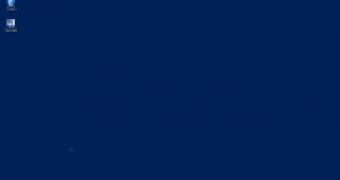
 14 DAY TRIAL //
14 DAY TRIAL // 
